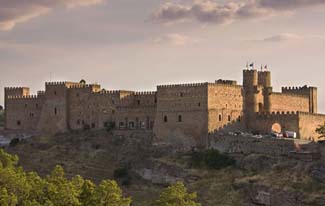
Photos courtesy of Parador de Sigüenza
Plaza del Castillo, s/n
19250 Sigüenza (Guadalajara)
Tel: ++34 949 39 01 00
Fax: ++34 949 39 13 64
Official parador website
Reserve with Booking.com
81 rooms
Double rooms: 95–185 euros
Single rooms: 80% of double
room rate.
Rates include tax. Breakfast extra.
Free Wi-Fi
Open: all year
Sigüenza is 135 km northeast of Madrid. From the main Madrid-Zaragoza highway (National Road II), turn off onto C-204. A sign for the parador shows the way. Sigüenza is a stop on the main Madrid-Zaragoza train line.
On site: sauna; gym
Nearby: Walks through the
medieval town; the cathedral
(which displays an El Greco
painting; the Museo Antigua
(with a painting by Zurbarán); horseback riding
The thick walls of this trapezoidal castle surround a courtyard holding a well remaining from the Moorish period.
Its entrance, flanked by twin towers, faces the town and has remained unchanged for seven centuries. Smaller towers flank the castle’s western side, and beneath them is a labyrinth of subterranean rooms, cellars, and dungeons.
Decoration inside the castle is in a medieval style, with one public lounge featuring two fireplaces, several enormous chandeliers, suits of armor, tapestries, and bright banners.
The sumptuous “Salón de Trono,” or throne room, was once a judicial courtroom. One tiny room is said to be the room where Doña Blanca was locked up by her husband Pedro the Cruel.
Like the rest of the castle, guest rooms are spotlessly clean and simply furnished with carved wooden furniture and hand woven rugs. Some have large canopy beds and balconies looking out over a valley filled with orchards and pine trees.
A wood-beamed ceiling highlights the main dining room. The menu features Castilian dishes such as roast kid, lamb, and succulent pork in wine sauce.
![]() Sigüenza is classified as a Spanish National Monument.
Sigüenza is classified as a Spanish National Monument.
![]() 13th-century Romanesque chapel
13th-century Romanesque chapel